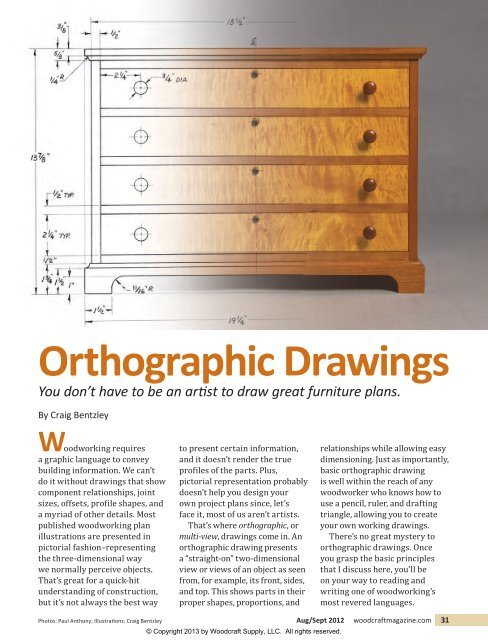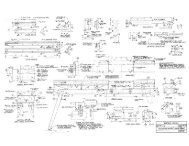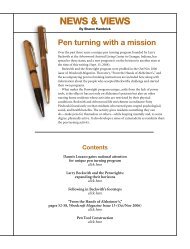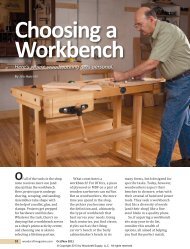Orthographic Drawings - Woodcraft Magazine
Orthographic Drawings - Woodcraft Magazine
Orthographic Drawings - Woodcraft Magazine
- No tags were found...
You also want an ePaper? Increase the reach of your titles
YUMPU automatically turns print PDFs into web optimized ePapers that Google loves.
Think “inside the box”Surely you’re familiar with thephrase “think outside the box.”With orthographic drawings,the opposite is true. Youneed to visualize an object asbeing inside a glass box, withthe object’s various profilesprojected onto the box’s sides. Asshown in the series of drawingsat right, first imagine each viewprojected onto its respectiveside of the box. Then unfold thebox to display the views in theirproper relationship to each otherwhen represented on the page.Since a box has six sides,you have the opportunity toillustrate the object in six viewsor elevations. Most furnitureprojects require only a front view,a side view, and occasionallya top view. Usually, the mostdescriptive view is selectedto be the front view, which isplaced in the lower left quadrantof the drawing. The right sideview is placed in the lower rightquadrant, and the top view (ifneeded) is placed at top left.Lines of projectionVisualize your project1 in a glass box.Construction linesSeveral lines are commonly usedto denote the outlines of partsand the location of holes. For thesake of discussion, I’ll call these“construction lines.” They includeobject lines, hidden lines, andcenterlines, as shown in Figure 1.Object lines are the mostimportant of these. Theyrepresent all of the visual aspectsof an actual object when viewedstraight-on. For example, objectlines show the perimeter of acabinet as well as all the edgesof its face frame, door, moldings,pulls, and every other line that theeye actually sees. On a drawing,object lines are rendered thethickest and darkest of all.Hidden lines are used todepict any internal elements orfeatures that are obscured innormal view, such as joinery orinterior surfaces. These linesare rendered lighter and thinnerthan object lines and consistof a series of short dashes ofequal length that are separatedby spaces of shorter distance.Centerlines are used to showaxial symmetry, in which one halfof the object is a mirror imageof the other. Like hidden lines,they are lighter and thinner thanobject lines. A centerline consistsof a series of short dashes, eachof which is separated by a muchlonger dash. Centerlines are alsoused to locate holes, in which32 woodcraftmagazine.com Aug/Sept 2012










